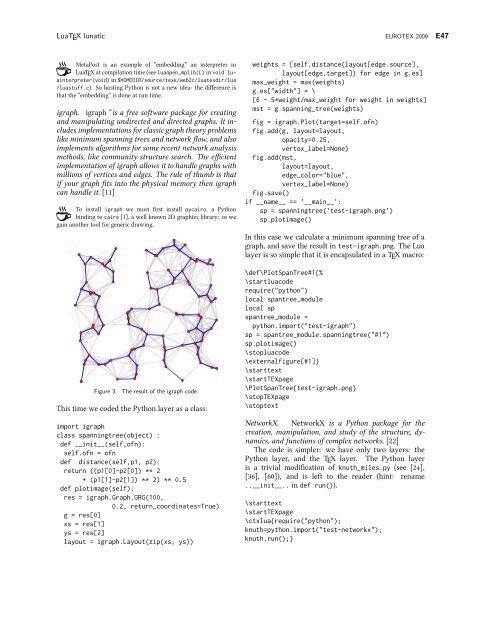Complete issue 30:3 as one pdf - TUG
Complete issue 30:3 as one pdf - TUG
Complete issue 30:3 as one pdf - TUG
You also want an ePaper? Increase the reach of your titles
YUMPU automatically turns print PDFs into web optimized ePapers that Google loves.
LuaTEX lunatic EUROTEX 2009 E47<br />
MetaPost is an example of “embedding” an interpreter in<br />
LuaTEXatcompilationtime(seeluaopen_mplib(L)invoid luainterpreter(void)in$HOMEDIR/source/texk/web2c/luatexdir/lua<br />
/lu<strong>as</strong>tuff.c). So hosting Python is not a new idea: the dierence is<br />
thatthe “embedding” isd<strong>one</strong>at run time.<br />
igraph. igraph “is a free software package for creating<br />
and manipulating undirected and directed graphs. It includesimplementationsforcl<strong>as</strong>sicgraphtheoryproblems<br />
likeminimumspanningtreesandnetworkow,andalso<br />
implementsalgorithmsforsomerecentnetworkanalysis<br />
methods, like community structure search. The ecient<br />
implementationofigraphallowsittohandlegraphswith<br />
millions of vertices and edges. The rule of thumb is that<br />
if your graph ts into the physical memory then igraph<br />
canhandleit. [11]<br />
To install igraph we must rst install pycairo, a Python<br />
binding to cairo [1], a well known 2D graphics library: so we<br />
gain anothertoolforgenericdrawing.<br />
Figure 3. The result of the igraph code.<br />
Thistime we coded the Pythonlayer <strong>as</strong>acl<strong>as</strong>s:<br />
import igraph<br />
cl<strong>as</strong>s spanningtree(object) :<br />
def __init__(self,ofn):<br />
self.ofn = ofn<br />
def distance(self,p1, p2):<br />
return ((p1[0]-p2[0]) ** 2<br />
+ (p1[1]-p2[1]) ** 2) ** 0.5<br />
def plotimage(self):<br />
res = igraph.Graph.GRG(100,<br />
0.2, return_coordinates=True)<br />
g = res[0]<br />
xs = res[1]<br />
ys = res[2]<br />
layout = igraph.Layout(zip(xs, ys))<br />
weights = [self.distance(layout[edge.source],<br />
layout[edge.target]) for edge in g.es]<br />
max_weight = max(weights)<br />
g.es["width"] = \<br />
[6 - 5*weight/max_weight for weight in weights]<br />
mst = g.spanning_tree(weights)<br />
fig = igraph.Plot(target=self.ofn)<br />
fig.add(g, layout=layout,<br />
opacity=0.25,<br />
vertex_label=N<strong>one</strong>)<br />
fig.add(mst,<br />
layout=layout,<br />
edge_color="blue",<br />
vertex_label=N<strong>one</strong>)<br />
fig.save()<br />
if __name__ == ’__main__’:<br />
sp = spanningtree(’test-igraph.png’)<br />
sp.plotimage()<br />
In this c<strong>as</strong>e we calculate a minimum spanning tree of a<br />
graph, and save the result in test-igraph.png. The Lua<br />
layer isso simplethat it isencapsulated inaTEX macro:<br />
\def\PlotSpanTree#1{%<br />
\startluacode<br />
require("python")<br />
local spantree_module<br />
local sp<br />
spantree_module =<br />
python.import("test-igraph")<br />
sp = spantree_module.spanningtree("#1")<br />
sp.plotimage()<br />
\stopluacode<br />
\externalfigure[#1]}<br />
\starttext<br />
\startTEXpage<br />
\PlotSpanTree{test-igraph.png}<br />
\stopTEXpage<br />
\stoptext<br />
NetworkX. NetworkX is a Python package for the<br />
creation, manipulation, and study of the structure, dynamics,and<br />
functionsof complexnetworks. [22]<br />
The code is simpler: we have only two layers: the<br />
Python layer, and the TEX layer. The Python layer<br />
is a trivial modication of knuth_miles.py (see [24],<br />
[36], [60]), and is left to the reader (hint: rename<br />
..__init__.. in def run()).<br />
\starttext<br />
\startTEXpage<br />
\ctxlua{require("python");<br />
knuth=python.import("test-networkx");<br />
knuth.run();}

















